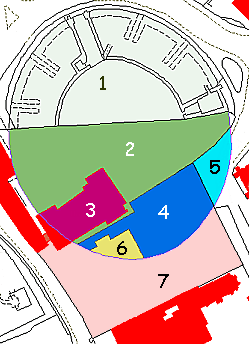
The amphitheatre is expected to have differential survival resulting from a number of factors. The northern section (Area 1), which is believed to have been excavated to natural over most of its area, may have no survival of archaeological stratigraphy, although masonry from the amphitheatre's interior survives well, particularly the arena wall and major entrances. The evaluation carried out by Lancaster University Archaeological Unit in 1993 showed that the northern car park and gardens of Dee House (Area 2) are also likely to have good survival of masonry. Roman and post-medieval stratigraphy also survives here, although the status of medieval and early medieval deposits is less clear.

Beneath the historic core of Dee House itself (Area 3), there is unlikely to be much stratigraphy surviving above the natural subsoil where cellars exist (Buxton 1993, 174). In other places, though, foundations for the stone amphitheatre survived in a truncated form, such as the remains of the concentric wall located in Trench 18. It appears that the truncation has largely affected post-Roman deposits where cellarage does not exist, although, as Kath Buxton (1993, 187) notes, even in cellared areas, cut features of Roman date have survived.
Beneath the 1920s extension (Area 6), however, survival appears to be somewhat better, as this part does not have cellarage. The survival beneath the eastern car park (Area 4) is also likely to be reasonable, with the same proviso that little is known of medieval and early medieval stratigraphy in this area (Cleary et al. 1994). The part of the amphitheatre that extends beneath Little St John Street towards the northwestern tower of St John's church (Area 5) is less likely to survive well. This is partly because of the provision of services along the road line and through a consideration of the line of the road: had Roman masonry survived here as elsewhere, it should have provided a substantial impediment to the growth of a right of way. Finally, Area 7 consists of the area to the south and southwest of the amphitheatre; preservation in this area will vary according to the type of development (falling in the ranges represented by Areas 3, 4 and 6.
On to tabulated breakdowns of estimated archaeological survival by area
Skip the figures: take me to a summary of the questions we can ask about the amphitheatre